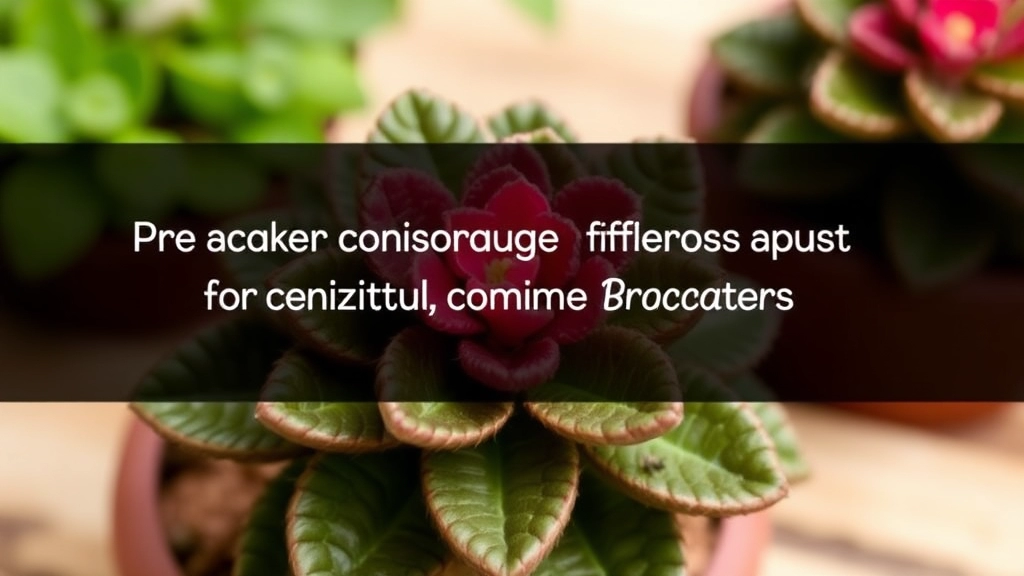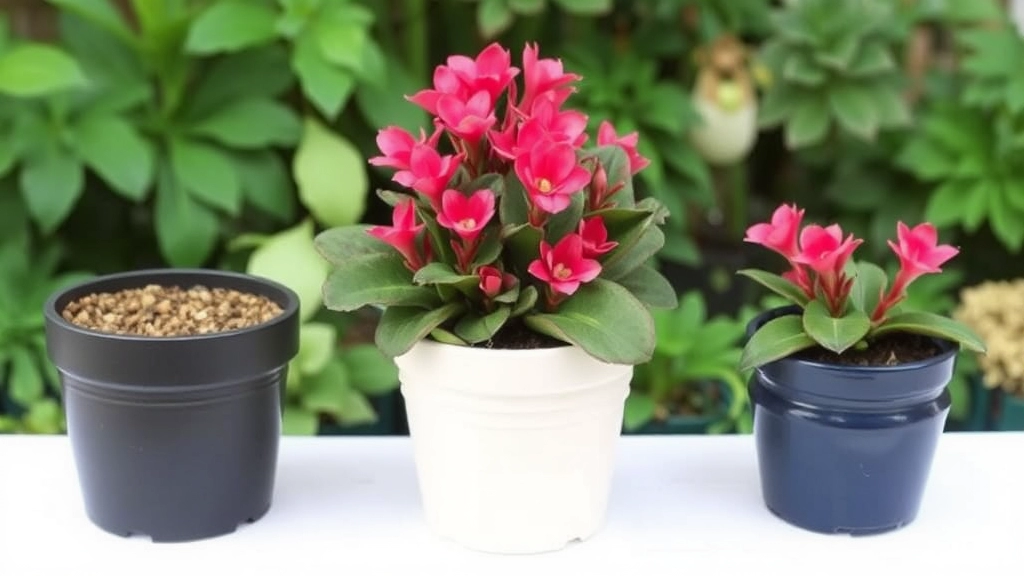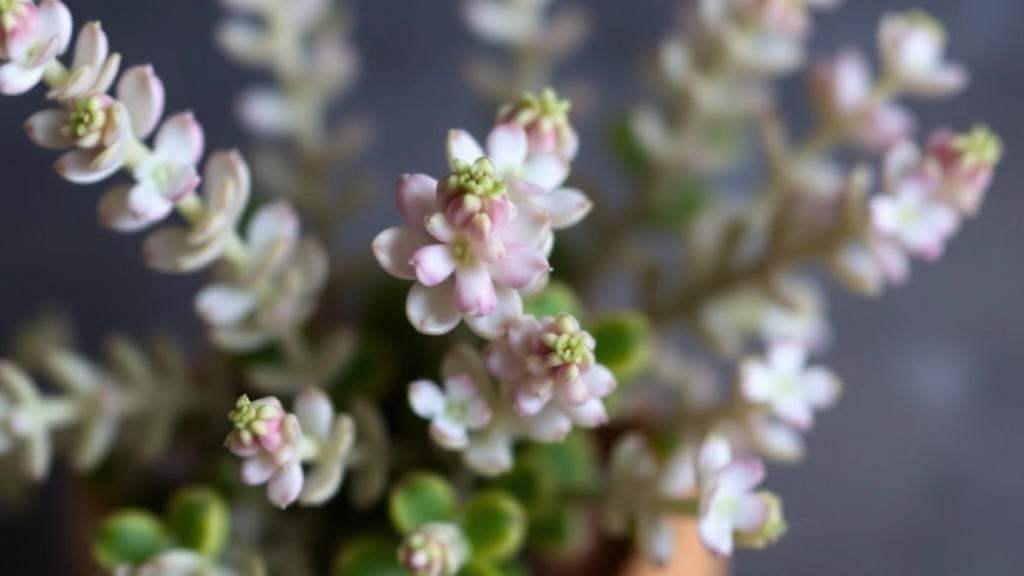Kalanchoe Bracteata Silver Spoons
Are you intrigued by the unique allure of the Kalanchoe Bracteata Silver Spoons? This succulent, known for its silvery, spoon-shaped leaves, is a favourite among plant enthusiasts. It thrives in bright, indirect light and prefers warmer temperatures, making it perfect for indoor cultivation. However, don’t forget to provide it with well-draining soil and be cautious with watering to prevent root rot.
Propagating Kalanchoe Bracteata Silver Spoons is a breeze. Simply take leaf cuttings, let them callous, and plant them in suitable soil. Regular pruning and repotting can help maintain its health and appearance. Additionally, watch out for common pests and diseases, and adjust care routines seasonally to keep your plant thriving all year round.
Light and Temperature Preferences for Kalanchoe Bracteata
When it comes to caring for Kalanchoe Bracteata, understanding its light and temperature preferences is crucial. Many plant enthusiasts often wonder why their Kalanchoe isn’t thriving.
Light Requirements
Kalanchoe Bracteata thrives in bright, indirect sunlight. Here are some key points to consider:
- Optimal Light: Aim for 6-8 hours of bright light daily.
- Avoid Direct Sunlight: Too much direct sun can scorch the leaves.
- Indoor Positioning: A south or west-facing window is ideal. If natural light is limited, consider using grow lights.
Temperature Preferences
This succulent prefers a warm environment. Here’s what you need to know:
II. Ideal Soil and Watering Requirements for Kalanchoe Bracteata
So, you’ve got your Kalanchoe Bracteata and you’re wondering about the best soil and watering practices to keep it thriving.
Let’s dive into what makes this plant tick.
Soil Requirements
Kalanchoe Bracteata loves well-draining soil. Here’s what you should look for:
- Cactus or Succulent Mix: These mixes are designed to let water pass through quickly, preventing root rot.
- Add Perlite or Sand: If you’re feeling adventurous, mix in some perlite or coarse sand to boost drainage even more.
- pH Level: Aim for a slightly acidic to neutral pH (around 6.0 to 7.0).
Using the right soil is crucial for healthy growth. Poor soil can lead to all sorts of issues, from stunted growth to pesky pests.
Watering Tips
Now, onto watering—perhaps the most common concern for plant parents.
- Less is More: Kalanchoe prefers to dry out between waterings. Overwatering is a quick path to disaster.
- Check the Soil: Stick your finger about an inch into the soil. If it feels dry, it’s time to water.
- Water Thoroughly: When you do water, give it a good soak until water drains from the bottom of the pot.
- Seasonal Adjustments: In the growing season (spring and summer), you might need to water more frequently, while in the dormant months (fall and winter), cut back.
Getting the watering right can be a game-changer for your Kalanchoe Bracteata.
How to Propagate Kalanchoe Bracteata: Step-by-Step Guide
If you’ve ever wondered how to expand your collection of Kalanchoe Bracteata, you’re not alone. Propagation can seem daunting, but it’s a rewarding process that can lead to new plants thriving in your home.
Understanding the Basics of Propagation
Kalanchoe Bracteata is a resilient succulent that can be propagated through two main methods: leaf cuttings and offsets. Each method has its unique benefits, so let’s dive into the step-by-step guide.
Method 1: Leaf Cuttings
- Choose a Healthy Leaf:
- Select a mature, healthy leaf from the parent plant.
- Ensure it’s free from any blemishes or pests.
- Cut the Leaf:
- Use a clean, sharp knife or scissors to cut the leaf at the base.
- Aim for a clean cut to prevent damage.
- Allow to Callus:
- Place the leaf on a dry surface for 2-3 days.
- This helps the cut end to callus over, reducing the risk of rot.
- Prepare the Soil:
- Use a well-draining soil mix, ideally a cactus or succulent blend.
- Fill a small pot with this mix.
- Plant the Leaf:
- Insert the callused end of the leaf into the soil, about 1-2 cm deep.
- Water lightly to settle the soil around the leaf.
- Provide the Right Conditions:
- Place the pot in a warm, bright spot, but avoid direct sunlight initially.
- Mist the soil occasionally to keep it slightly moist.
- Wait for Roots to Develop:
- In a few weeks, you should see roots forming, followed by new growth.
Method 2: Offsets
- Identify Offsets:
- Look for small offsets or âpupsâ growing around the base of the parent plant.
- These are mini versions of the parent and are ready for propagation.
- Remove the Offset:
- Gently twist or cut the offset from the parent plant.
- Ensure it has some roots attached for successful growth.
- Allow to Callus (if necessary):
- If the offset has been cut, let it callus for a day or two.
- Plant the Offset:
- Place the offset in a pot with well-draining soil.
- Water lightly and place in a warm, bright spot.
- Care for the New Plant:
- Treat it like a mature Kalanchoe Bracteata, ensuring it gets adequate light and water.
By following these straightforward steps, you’ll soon have new Kalanchoe Bracteata plants to enjoy or share with friends. If you are interested in other Kalanchoe varieties, you might find the Kalanchoe Mother of Thousands Propagation Guide helpful. Additionally, for more tips on Kalanchoe care, check out our Complete Guide to Kalanchoe Plant Care.
Preventing Common Pests and Diseases in Kalanchoe Bracteata

As we delve deeper into the care of Kalanchoe Bracteata, it’s essential to address the common pests and diseases that can affect its health.
Common Pests to Watch For:
- Aphids: These tiny insects can cluster on new growth, sucking sap and causing leaves to curl.
- Mealybugs: Recognisable by their white, cotton-like appearance, mealybugs can weaken your plant significantly.
- Spider Mites: If you notice fine webbing on your Kalanchoe, spider mites could be the culprit, leading to yellowing leaves.
- Scale Insects: These pests appear as small, brown bumps on stems and leaves, robbing your plant of vital nutrients.
Preventive Measures:
- Regular Inspections: Check your plant weekly for any signs of pests.
- Clean Leaves: Wipe leaves with a damp cloth to remove dust and deter pests.
- Neem Oil: A natural pesticide that can be sprayed on leaves to prevent infestations.
Common Diseases to Be Aware Of:
- Root Rot: Caused by overwatering, leading to mushy roots.
- Leaf Spot: Fungal infections that create dark spots on leaves, often due to excess moisture.
Preventive Strategies:
- Proper Watering: Ensure your Kalanchoe Bracteata is in well-draining soil and only water when the top inch of soil is dry.
- Good Air Circulation: Position your plant where it can receive adequate airflow, reducing humidity around it.
Pruning and Repotting Tips for Healthier Growth
When caring for your Kalanchoe Bracteata, pruning and repotting are essential practices that can significantly enhance its growth and health. You might wonder, “How do I know when to prune or repot my plant?” Here’s a straightforward guide to help you navigate these tasks effectively.
Pruning Your Kalanchoe Bracteata
Pruning is vital for maintaining the shape and vitality of your plant. Here are some key points to consider:
- Timing: The best time to prune is during the spring or early summer. This allows the plant to recover quickly.
- Tools: Use sharp, clean scissors or pruning shears to avoid damaging the plant.
- What to Cut:
- Remove any dead or yellowing leaves.
- Trim back leggy stems to encourage bushier growth.
- Cut off spent flowers to promote new blooms.
- Technique: Always cut just above a leaf node to stimulate new growth.
Pruning not only keeps your Kalanchoe looking its best but also prevents overcrowding, which can lead to disease.
Repotting Your Kalanchoe Bracteata
Repotting is another crucial step to ensure your plant thrives. Here’s how to do it effectively:
- When to Repot: Generally, you should repot every two years or when the roots outgrow the current pot.
- Choosing a Pot: Opt for a pot that is one size larger and has drainage holes to prevent waterlogging.
- Soil Requirements: Use a well-draining cactus mix or a blend of potting soil and perlite to ensure proper aeration.
- Steps to Repot:
- Gently remove the plant from its current pot.
- Loosen any tightly bound roots.
- Place the plant in the new pot, filling in with fresh soil.
- Water lightly to settle the soil.
Repotting helps refresh the nutrients in the soil and gives your Kalanchoe Bracteata room to grow. For more detailed tips, check out our pruning guide and our leaf problem solutions to keep your plant healthy and vibrant.
Choosing the Right Pot for Your Kalanchoe Bracteata

So, you’ve got your Kalanchoe Bracteata all set up and thriving. But wait—what about the pot? Choosing the right pot is crucial for ensuring your plant stays healthy and happy.
Why Does the Pot Matter?
- Drainage: Kalanchoe loves well-draining soil. A pot with drainage holes is a must to prevent water from sitting at the bottom.
- Size: Pick a pot that’s just a bit bigger than the root ball. Too much space can lead to overwatering issues.
- Material: Terracotta pots are great because they breathe, helping to keep the roots dry. Plastic pots are lighter and retain moisture, but they can lead to root rot if you’re not careful.
Quick Tips for Pot Selection:
- Check for Drainage Holes: Always opt for pots with holes at the bottom.
- Consider the Weight: If you plan to move your plant around, a lighter pot might be your best bet.
- Think About Aesthetics: Choose a pot that matches your decor; it’s all about that vibe!
Examples to Consider:
- A 4-6 inch terracotta pot is perfect for younger plants.
- For a mature Kalanchoe, look at a 6-8 inch ceramic pot that suits your style.
Seasonal Care Adjustments for Kalanchoe Bracteata
As we transition through the seasons, it’s essential to adapt our care routine for Kalanchoe Bracteata to ensure its continued health and vibrancy. The changing weather can significantly impact how we should care for this beautiful succulent.
Spring: Awakening Growth
In spring, Kalanchoe Bracteata emerges from dormancy. This is the perfect time to:
- Increase Watering: As temperatures rise, your plant will need more moisture. Water when the top inch of soil feels dry.
- Fertilise: Use a balanced, diluted fertiliser every four to six weeks to support new growth.
- Repotting: If your plant has outgrown its pot, consider repotting to encourage healthy root development.
Summer: Thriving in the Heat
Summer brings warmth, and your Kalanchoe will thrive with proper care:
- Light Exposure: Ensure it receives bright, indirect sunlight. Too much direct sun can scorch its leaves.
- Watering Routine: Water more frequently, but ensure the pot drains well to prevent root rot.
- Humidity Check: Keep an eye on humidity levels; if it gets too high, ensure good airflow around the plant.
Autumn: Preparing for Dormancy
As temperatures begin to cool, it’s time to prepare your Kalanchoe for dormancy:
- Reduce Watering: Cut back on watering as the plant’s growth slows.
- Fertiliser: Discontinue fertilising in late autumn to allow the plant to rest.
- Check for Pests: Inspect your plant regularly, as pests may seek shelter as it cools down.
Winter: Minimal Care
In winter, Kalanchoe Bracteata enters a dormant phase. During this time:
FAQs About Kalanchoe Bracteata Silver Spoons
What type of soil is best for Kalanchoe Bracteata?
Kalanchoe Bracteata thrives in well-draining soil. A cactus or succulent mix is ideal, and you can enhance drainage by adding perlite or coarse sand. Aim for a slightly acidic to neutral pH, around 6.0 to 7.0.
How often should I water my Kalanchoe Bracteata?
Watering should be done when the top inch of soil feels dry. Overwatering can lead to root rot, so it’s better to let the soil dry out between waterings. During the growing season (spring and summer), you may need to water more frequently, while in the dormant months (fall and winter), reduce watering.
What are common pests that affect Kalanchoe Bracteata?
Common pests include aphids, mealybugs, spider mites, and scale insects. Regular inspections and cleaning of leaves can help prevent infestations. Neem oil is also a natural pesticide that can be used to deter pests.
How can I prevent diseases in my Kalanchoe Bracteata?
To prevent diseases like root rot and leaf spot, ensure your plant is in well-draining soil and only water when the top inch of soil is dry. Good air circulation around the plant can also reduce humidity and prevent fungal infections.
What kind of pot is suitable for Kalanchoe Bracteata?
A pot with drainage holes is essential to prevent water from sitting at the bottom. Terracotta pots are recommended as they breathe and help keep the roots dry. Choose a pot that is just a bit larger than the root ball to avoid overwatering issues.
Can I use a plastic pot for my Kalanchoe Bracteata?
Yes, you can use a plastic pot, but be cautious as they retain moisture and can lead to root rot if not managed properly. Ensure the plastic pot has adequate drainage holes.
How can I enhance the aesthetic appeal of my Kalanchoe Bracteata?
Choose a pot that matches your decor. For younger plants, a 4-6 inch terracotta pot is perfect, while a 6-8 inch ceramic pot can be ideal for mature plants. Consider the pot’s weight if you plan to move your plant around frequently.
What should I do if I notice pests on my Kalanchoe Bracteata?
Regularly inspect your plant for pests. If you notice any, wipe the leaves with a damp cloth and use neem oil as a natural pesticide. Early detection and treatment are key to preventing infestations.
Why is my Kalanchoe Bracteata developing dark spots on its leaves?
Dark spots on leaves can be a sign of leaf spot, a fungal infection often caused by excess moisture. Ensure proper watering practices and good air circulation to prevent this disease.
Can I mix my own soil for Kalanchoe Bracteata?
Yes, you can mix your own soil by combining a cactus or succulent mix with perlite or coarse sand to enhance drainage. This custom mix can help meet the plant’s specific soil requirements.
References
-
Growing Kalanchoe Indoors – The Spruce
-
Kalanchoe Plant Care – Gardening Know How
-
Kalanchoe: How to Grow and Care for Kalanchoe Plants – The Old Farmer’s Almanac
